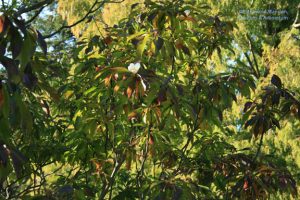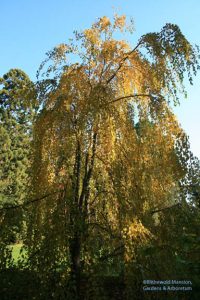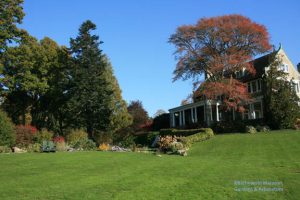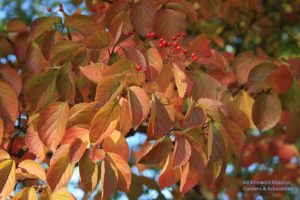Fall feast
It might all be eye candy but it’s delicious outside! Yesterday was one of those amazing, quintessentially New England, fall days – cloudless cerulean sky framing the blazing end of the earth’s color spectrum – and I ate it up. As soon as I could, I hightailed it out of the greenhouse (where spray mounted bubble wrap is peeling off the panes like a bad sunburn — we’ve conceded failure, alas) and went for an afternoon photo-op walk in search of some major and minor things worth planting for extra special fall color. (Today is the other kind of New England fall day: chill grey bluster and rain. The kind of day to stay inside and write about yesterday.)
Common witch hazel (Hamamelis virginiana) is turning a sort of ordinary yellow but if you take the trouble to move in for a closer look, you’ll see the extraordinary yellow blooms uncrimping. It’s native to the eastern U.S., hardy in zones 3-8 and ours is a sizable shrub about the size of the potting shed.
Another blooming beauty – and again you have to have your eyes peeled for the blooms – is the Franklinia alatamaha. It’s also worth stepping up to this tree to see the subtle slow burn of the leaf colors. Native to Georgia and possibly extinct in the wild, this small tree is truly a beauty worth preserving. Hardy from zones 6-9, our Franklinia is tucked in a sunny protected spot on the front lawn of the house.
The Katsuras (Cercidiphyllum japonicum) are eye candy that happen to smell like candy. Every time I walk under this tree I am struck by the shadows it casts (there’s no prettier silhouette on the ground), the blaze of fall color that lights it like a candle and the mysterious sugar scent of its fallen leaves (I can’t detect it from a single crushed leaf – it takes a path-full evidently). Hardy zones 4-8, Katsuras can reach 70′. We also have a Weeping Katsura (Cercidiphyllum japonicum ‘Pendulum’) which reminds me of Cousin It.
Fall flame colors need a foil and I know I’ve gone on about Chrysanthemum (or Dendranthema) ‘Sheffield Pink’ before (full sun, zones 4-8). It’s a perfectly autumnal pink and I wish I had a patch at my house to reverberate against my burgundy-wine dipped flowering dogwood.
Amsonia hubrechtii is an autumn must-have native perennial (zones 5-9). It has a pale blue star flower moment in the spring, a lengthy summer plain green featheriness and then a bright blaze now. It’s the flash of yellow along the wall of the North Garden in the picture below. As always, click on images for a larger view. The Tupelo (Nyssa sylvatica) against the house is one of my other major fall favorites because it starts the whole show in August with a few well placed red patches high in the canopy and then keeps on coloring.
The Linden viburnum (Viburnum dilatatum) is turning shades of peachy orange so of course it made it on my list and the bright red fruit is an added eye treat. (A good sized shrub – ours are about 10′ tall. Zones 5-8) Seven-son flower (Heptacodium miconioides) is another star for the showy bracts left over from the sweet September flowers. Some don’t find the scent altogether pleasing but it reminds me of honey soap. (Tall shrub to 20′ and hardy in zones 6-9)
I could go on and on – I haven’t even mentioned a single maple yet! That’ll be for another post perhaps. Meanwhile I’m going to try to picture where in my own garden I can fit a few of these delicious plants and where in my neighbor’s yard I could sneak a Tupelo… What’s your favorite eye candy this fall? Are you planning on planting anything specifically to satisfy a fall craving?










